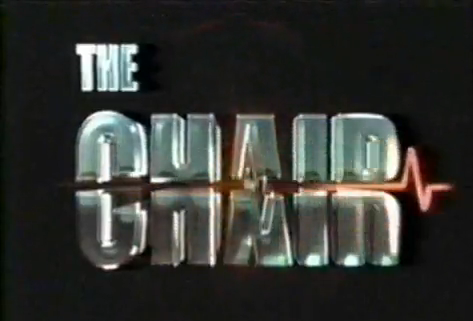I'm John McEnroe and I've got a small
fortune for anyone who can beat...

SHOW: THE CHAIR
AIR DATES: January 15, 2002 to March 19, 2002
CREATOR: Julie Christie, Touchdown Television, Trailpolis Entertainment
Group
HOST: John McEnroe
WATCH IT AT: YouTube
We all know that coming up with a fresh new idea for a game show is a
daunting task. Especially a game show on prime-time network television
where even ABC, still riding a high on "Millionaire", wasn't just
resting on its laurels. But what happens when two different companies go
to two different networks and, essentially, pitch the SAME GAME?! This
is what happened in January 2002 when ABC and FOX respectively aired
"The Chair" and "The Chamber", two shows with very similar premises:
people are strapped in and forced to answer questions under duress and,
if they fail to stay calm, they lose the money they worked so hard to
earn. This lead to both production companies suing the other for
infringement (nothing came of it, by the way). I'll deal with FOX's poor
excuse for a show next time. For now, let's focus on ABC's SLIGHTLY more
popular version where a person is strapped into a chair and forced to
look at John McEnroe's ugly mug for money.
HOW WAS IT PLAYED?
PRE-SHOW
Potential contestants are given a battery of tests. And these tests not
only show how smart they are but how they perform under pressure. And by
"pressure", that usually means performing mental tasks during jump
scares. Only those declared fit to handle this kind of pressure could
play the game. After all, we can't have someone having a heart attack on
national television, can we?
MAIN GAMEPLAY
The contestant is strapped into The Chair and is raised into an
arena-like studio, the host looking down on them. They have heart
monitors checking their heart rate, which is the most important part of
this game. They are given a starting stake of $5000 but they can only
hold on to the money if they kept their heart rate below a certain
threshold. Before the show, their resting heart rate is measured. The
threshold., or "redline" is set to 60% (later 70%) above the resting
rate. In other words, if a contestant's resting rate is 80 beats per
minute, the threshold. starts at 128 (later 136) beats per minute.
The host asks the contestant seven questions, each one of increasing
difficulty and which can earn the contestant more money. The trick is
that the contestant can ONLY answer if their heart rate is not above the
"redline". If it IS, as soon as the host finishes the question, the
contestant LOSES money from their stake. If they run out of money at any
time, the game ends and the contestant leaves with nothing. When the
contestant's heart rate goes below the "redline", the host says they can
answer the question. They can take as long as they want to answer but
they must answer before their heart rate "redline"s, losing them more
money. If a contestant gets the question right, they earn money and the
monitoring is paused until the next question...except in the case of "Heartstoppers"
(explained later). For each consecutive question, the "redline" drops by
5% of the resting rate (4 bpm in the above example).
Contestants earn $5000 for getting the first question right, $10,000 for
the second, then $15,000, $25,000, $40,000, $50,000 and finally $100,000
for the final question. Upon going above the "redline", the contestant
loses $100 for each second during the first two questions, then $100
more for each question through the sixth and finally $1000 per second
for the final question. The maximum someone can win is $250,000. If a
question is answered wrong, the game ends. If this happens in the first
three questions, the contestant leaves with nothing. After the third
question, though, the contestant is given a chance to "stabilize" the
money won to that point. This means that, should the contestant miss a
question, they still leave with the amount at which they "stabilized".
However, this does NOT count for "redlining"; the "stabilized" amount
drops if the total earned drops below said amount. The contestant may
"stabilize" at any point after a right answer is given, but can only do
it once.
Twice during the game, a "Heartstopper" occurs. This is something
SPECIFICALLY designed to scare the contestant, raise their heart rate
and make them lose more money. This could be anything from explosions
going off to a live snake or alligator lowered within inches of the
contestant...to the host serving tennis balls at their head (a plastic
shield protects the contestant). During these "Heartstoppers", the
contestant loses money if they "redline" at the rate of the previous
question's "redline" rate and continue until they get below the
"redline". If the contestant DOESN'T "redline" within the 15-second
duration, their money does not diminish until the start of the next
question.
One major rule is that the contestant MUST stay alert. They can do
whatever it takes to lower their heart rate EXCEPT close their eyes or
cover them for a long period of time. The host gives a warning if they
do so and, if they get three warnings, the game stops and the contestant
forfeits their winnings.
The game only ends when a) a question is answered wrong, b) all the
money has been "redlined" away, c) the host gives a third warning or d)
all seven questions are answered correctly. In the case of a), the
contestant leaves with any "stabilized" money. In the case of d), the
contestant leaves with a minimum of $100,100 and a maximum of $250,000
(which happened once).
WHAT WORKED?
Basing a game on how calm you are under pressure is QUITE unique, to say
the least. Show my ONE person who ain't excited about playing for
thousands of dollars on national television and I'll show you someone
who wouldn't qualify for this show 'cause they DON'T HAVE A PULSE! The
clip I have posted has someone who's heart rate didn't drop below the
initial "redline" for his ENTIRE run. How he got past the screening
process is beyond me.
I guess that, if you already have a show where answering 15 questions
gets you a million, having a show where you only answer SEVEN deserves a
lower payout. This was more about keeping your cool than getting the
right answer.
And though the "Heartstoppers" were a bit corny, they did their job for
the most part: they scared the crap outta the contestants in the hopes
of making them "redline". Didn't ALWAYS work, but it did most of the
time.
WHAT DIDN'T WORK?
I can understand why they chose John McEnroe. There wasn't a more loud,
intimidating tennis player in the late-70s and 80s. And yet, though this
is a show about getting the heart racing, he showed that he was really a
puppy when it comes to hosting. He wasn't his loud, intimidating self,
not even when he was the "Heartstopper". He wasn't even that exciting.
He was just...meh.
The main problem with the "Heartstoppers" was that the contestants were
given a bit of a warning before they happened. Oh, sure, they still
didn't know WHAT it was, but having that second or two of warning can
get someone mentally prepared for whatever it is. Also, as long as they
knew their lives weren't in danger and that they wouldn't get hurt, they
handled all the jump scares during the initiation. Why bother warning?
Changing up the questions was not the best thing ABC could've done. I
mean, yeah, it makes it stand out from every other prime time show
but...switching gears like that is not the best of strategies. It's like
they WANTED the contestants to lose before they "stabilized".
WOULD IT WORK TODAY?
Many, MANY versions of this game played around the world (hell, McEnroe
hosted the UK version in LATE-2002)...but the longest lasting versions
were in Russia and France (with France's lasting just over two years).
It was an interesting concept, no doubt...but the only thing that can be
said in the positive...is that it lasted MUCH longer than Fox's
so-called "rip-off". But that's a GGB for another time...as in...
NEXT TIME: The Great Game Show Rivalry of 2002, part 2
Chris Wolvie knows tennis is where love means nothing.
Follow him on Twitter
@ChrisWolvie
and e-mail him at
chriswolvie@yahoo.com. |


